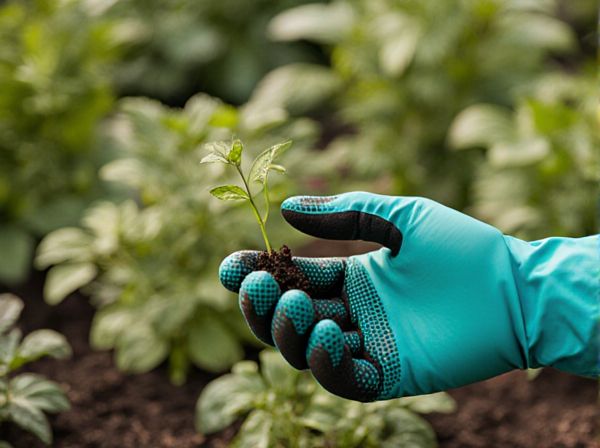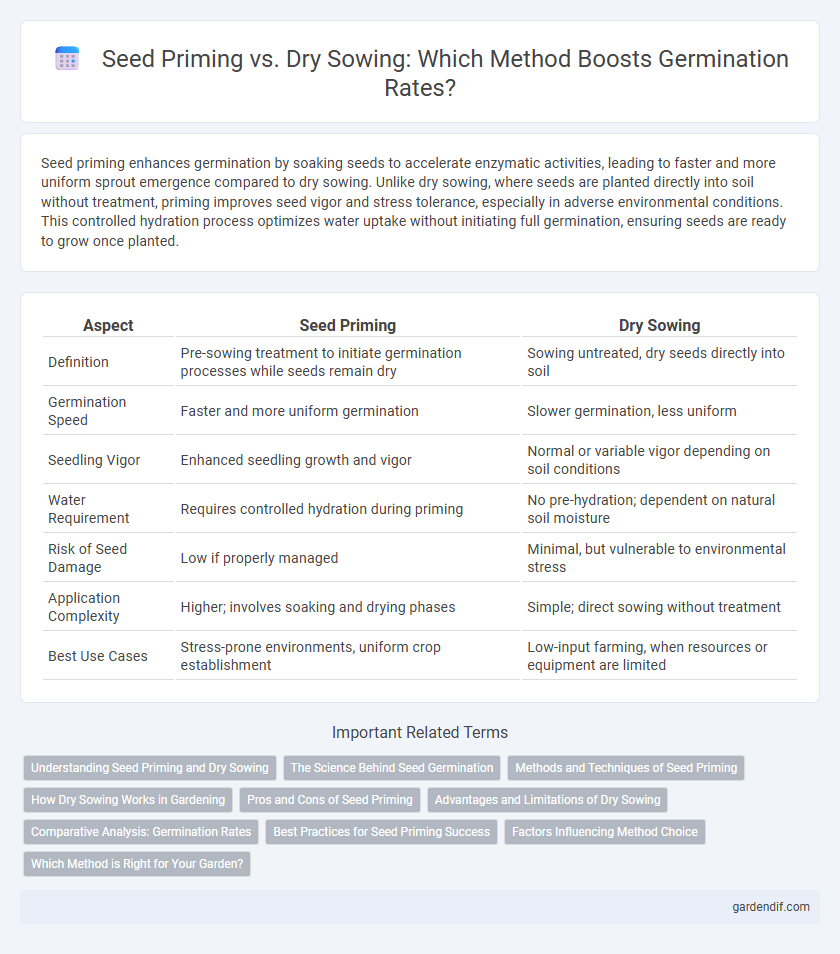
Seed Priming vs Dry Sowing Illustration
Seed priming enhances germination by soaking seeds to accelerate enzymatic activities, leading to faster and more uniform sprout emergence compared to dry sowing. Unlike dry sowing, where seeds are planted directly into soil without treatment, priming improves seed vigor and stress tolerance, especially in adverse environmental conditions. This controlled hydration process optimizes water uptake without initiating full germination, ensuring seeds are ready to grow once planted.
Table of Comparison
| Aspect | Seed Priming | Dry Sowing |
|---|---|---|
| Definition | Pre-sowing treatment to initiate germination processes while seeds remain dry | Sowing untreated, dry seeds directly into soil |
| Germination Speed | Faster and more uniform germination | Slower germination, less uniform |
| Seedling Vigor | Enhanced seedling growth and vigor | Normal or variable vigor depending on soil conditions |
| Water Requirement | Requires controlled hydration during priming | No pre-hydration; dependent on natural soil moisture |
| Risk of Seed Damage | Low if properly managed | Minimal, but vulnerable to environmental stress |
| Application Complexity | Higher; involves soaking and drying phases | Simple; direct sowing without treatment |
| Best Use Cases | Stress-prone environments, uniform crop establishment | Low-input farming, when resources or equipment are limited |
Understanding Seed Priming and Dry Sowing
Seed priming enhances germination by partially hydrating seeds to activate metabolic processes without radicle emergence, improving speed and uniformity during subsequent sowing. Dry sowing involves planting untreated seeds directly into the soil, relying on natural moisture for germination, which can result in slower and less uniform emergence. Understanding these methods helps optimize crop establishment by balancing speed, vigor, and environmental adaptability.
The Science Behind Seed Germination
Seed priming accelerates germination by initiating metabolic processes such as enzyme activation and DNA repair before sowing, enhancing uniformity and vigor. In contrast, dry sowing relies on natural soil moisture to trigger these physiological changes, often resulting in slower and less predictable germination. Understanding the biochemical and cellular events during seed imbibition and activation aids in optimizing techniques for improved crop establishment.
Methods and Techniques of Seed Priming
Seed priming involves controlled hydration techniques such as hydropriming, osmopriming, and biopriming to initiate metabolic processes before sowing, enhancing germination speed and uniformity. Hydropriming soaks seeds in water, osmopriming uses osmotic solutions like polyethylene glycol to regulate water uptake, while biopriming incorporates beneficial microbes to promote seedling vigor. These methods contrast with dry sowing, where untreated dry seeds are directly sown, often resulting in slower germination and less uniform emergence.
How Dry Sowing Works in Gardening
Dry sowing involves planting seeds directly into dry soil without prior soaking or treatment, allowing natural moisture levels and environmental conditions to trigger germination. This method relies on ambient rainfall or irrigation to initiate seed imbibition and activate metabolic processes necessary for seed sprouting. Dry sowing is particularly effective for crops adapted to local climates, reducing the risk of seed rot and promoting robust root development by encouraging gradual moisture uptake.
Pros and Cons of Seed Priming
Seed priming enhances germination speed and uniformity by pre-hydrating seeds under controlled conditions, leading to improved seedling vigor and higher crop yields. It also reduces the time for emergence and increases tolerance to environmental stresses like drought and salinity. However, seed priming requires precise moisture control to prevent premature germination or seed deterioration and involves additional labor and costs compared to dry sowing.
Advantages and Limitations of Dry Sowing
Dry sowing simplifies the planting process by allowing seeds to be sown directly into dry soil, which can improve timing flexibility and reduce labor costs. However, its limitations include the risk of uneven germination due to variable soil moisture and temperature conditions, often resulting in lower seedling vigor compared to seed priming techniques. Seed priming enhances germination rates and uniformity by pre-treating seeds to improve water uptake and metabolic readiness, but dry sowing remains valuable in regions with unpredictable rainfall or limited irrigation infrastructure.
Comparative Analysis: Germination Rates
Seed priming significantly enhances germination rates by initiating metabolic processes before sowing, resulting in faster and more uniform seedling emergence compared to dry sowing. Dry sowing often leads to delayed and uneven germination due to the lack of pre-sowing imbibition, especially under suboptimal environmental conditions. Studies indicate seed priming can increase germination rates by up to 30% depending on crop species and priming technique, offering a reliable advantage over traditional dry sowing methods.
Best Practices for Seed Priming Success
Effective seed priming involves soaking seeds in water or nutrient solutions to initiate germination processes before planting, enhancing uniformity and speed of emergence. Optimal conditions include controlling soaking time, temperature, and aeration to prevent seed damage and fungal growth. Using clean water, maintaining appropriate moisture levels, and timely drying of primed seeds before sowing ensure the best results compared to dry sowing methods.
Factors Influencing Method Choice
Seed priming enhances germination speed and uniformity by pre-soaking seeds under controlled conditions, which is ideal for crops requiring rapid establishment in stressful environments. Dry sowing is preferred in large-scale field operations and regions with unpredictable rainfall, as it enables seeds to remain dormant until natural moisture triggers germination. Factors influencing method choice include soil moisture availability, crop species, environmental conditions, and resource constraints such as labor and equipment.
Which Method is Right for Your Garden?
Seed priming enhances germination speed and uniformity by partially hydrating seeds before sowing, leading to stronger seedlings and improved stress tolerance. Dry sowing involves planting untreated seeds directly into the soil, which is simpler but often results in slower, less uniform germination, especially in adverse conditions. Choose seed priming for controlled environments or when fast establishment is critical, while dry sowing suits low-maintenance gardens and climates with reliable moisture.
Seed Priming vs Dry Sowing Infographic

 gardendif.com
gardendif.com